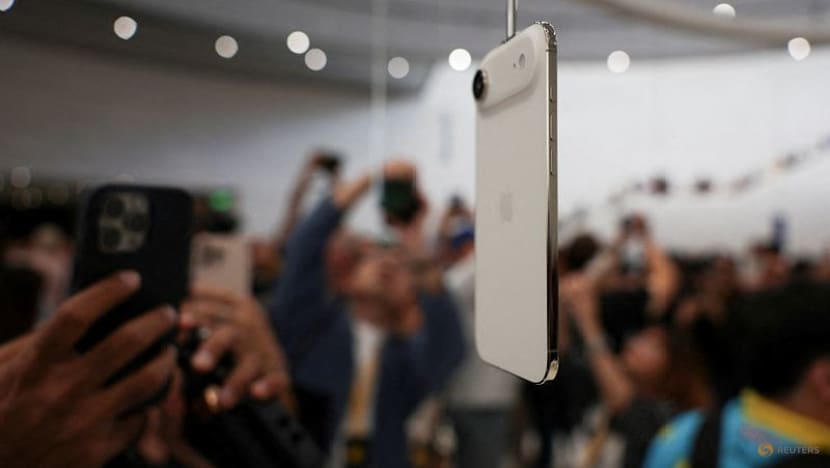Commentary: Who actually wants a thinner iPhone?
The iPhone Air sacrifices battery life and camera performance at a premium price, says Dave Lee of Bloomberg Opinion.

An iPhone Air hangs during an Apple's event at the Steve Jobs Theater on its campus in Cupertino, California, Sep 9, 2025. REUTERS/Manuel Orbegozo
NEW YORK: There was a time when thickness and weight were two main questions when buying new technology, maybe even the most important. That’s why, when Steve Jobs slipped a MacBook Air out of an envelope in 2008, we all oohed. It was a new dawn for laptops: finally some mercy for the world’s shoulders.
There were some performance trade-offs, but they were seen as worth it. The MacBook Air redefined expectations of how a laptop could look and feel, and it only got better from there. As well as MacBook Air, by 2013 we had the iPad Air, too.
Continuing the trend on Tuesday (Sep 9), Apple introduced the 5.64mm-thick iPhone Air to answer those critics who say that at 7.95mm, the new iPhone 17 is too thick, a certified whopper. If you can locate any of those critics, please send them to me because I don’t believe they exist.
Nor do I believe many consumers will care about thickness when they learn the iPhone Air means sacrificing things they worry about more than any other factor: battery life and a more capable camera.
These consumers also care about price. At US$999, the iPhone Air comes in at US$200 more than the more powerful 17, or just US$100 less than the full-featured 17 Pro. Is that a good deal to achieve thinness when you’re only going to stick this phone into a case immediately anyway?
This is one of the stranger products Apple has ever released. The company didn’t elaborate on what it meant by “all-day battery life”, but here’s a clue: Alongside the launch of the device, Apple showed off an accompanying external battery pack for “life’s busier days”. (It’s US$99.)
A MARKET RESEARCH OPPORTUNITY
So what’s the deal? Francisco Jeronimo, an analyst with IDC, said the design refresh – which includes a new look for the other iPhones in addition to the iPhone Air – is about shortening the amount of time consumers wait to upgrade their devices, which has been trending longer and longer as the phone and its components have improved and the phones have started to look very similar from one year to the next.
As CCS Insight’s Ben Wood put it, “It has been a few years since Apple has had new iPhones that you could put on the table in a coffee shop, meeting room or pub, and people would ask, ‘Is that the new iPhone?’”
So it was good news if that’s the sort of thing that matters to you: The new Pro lineup looks distinctly different from the models of the past few cycles, with its massive new camera bump – the company called it a “plateau” – and distinct new colours.
On matters of thinness, Jeronimo points to the Samsung’s S25 Edge – 5.8mm – which sold more than a million units in this year’s second quarter, making it the sixth most popular smartphone globally in IDC’s “high-premium” category of US$1,000 to US$1,600 – though online reviews, both professional and from regular people, bemoan the poor battery performance.
Those kind of sales numbers would be table stakes for Apple, but the S25 Edge at least signals an audience for thinner phones, Jeronimo argues. The iPhone Air, then, might be a consumer-testing and market research opportunity for Apple ahead of some truly large upgrades coming next year.
The iPhone Air makes use of Apple’s own wireless chip and modem. Spinning up the supply chain that produces them will be useful as Apple prepares for products like the highly anticipated folding iPhone, which will ultimately feel like two iPhones fused together. That device, far more than anything on show today, will be what gets people upgrading their iPhone more quickly.
All this leaves the iPhone Air as a niche product, built for those who simply must buy every new Apple product or those wear their jeans too tight (there’s probably plenty of overlap in that particular Venn diagram). Like the experimental Vision Pro – another case of Apple doing a little R&D and market research out in the open – it’s perhaps less about this first version of iPhone Air and more about the second one.
As Tim Cook wrapped up the launch event on Tuesday, Apple’s shares were trading marginally down – around 1.5 per cent. It was a muted response from investors who know the real litmus test of Apple’s strategy – on both AI and the future of the iPhone – won’t come until next year.















